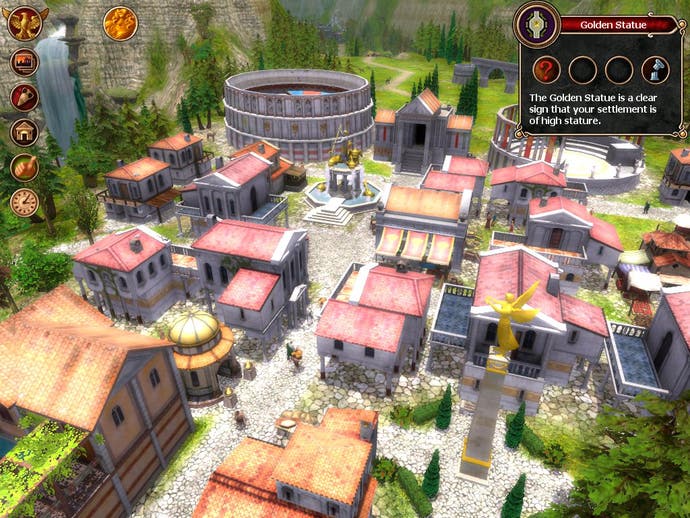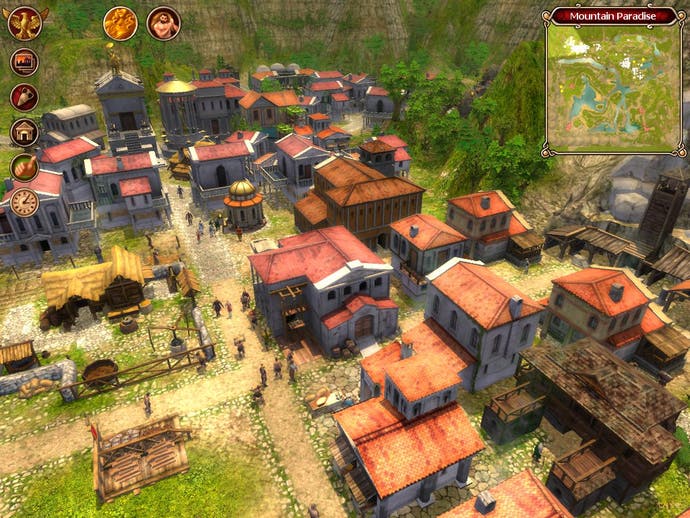Glory of the Roman Empire
Caesar pleaser?
I'd be as pleased as Punch if my three-year-old son Randolph grew up to be a games designer. To help him on his way I'm already employing a special Hungarian education technique called Realignment Through Play (RTP). It works like this: let's say he's playing with his Lego and builds a neat little model of our house or our car; on such occasions I reward him with affection and words of praise. If, on the other hand, he brings me a model of a huge blue horse drinking from a volcano, or a peacock with rockets instead of feathers, I smash it to bits in front of him and rage until he blubs.
I know it sounds cruel, but really it isn't. By teaching him to suppress his imagination and mimic the objects he sees around him, I'm equipping him with exactly the kind of mindset he'll eventually need to get ahead in mainstream game design. With luck one day he'll be making products as fresh, iconoclastic, and crammed with surprises as Glory of the Roman Empire.
Indulgent intro ends here
Apologies for the cynicism. Glory might be completely devoid of original ideas, but at least it's competently constructed and entertaining in a bland, non-threatening sort of way. Like any half-decent city-building game, there's a definite momentum to the action; you start a scenario by plopping down a few thatched hovels, farms and mines on a spacious map, and, before you know it, an hour has passed and there you are earnestly scouring a vast brick and marble sprawl for room to place just one more gold-leafed statue of Bacchus, God of winos. The economics are complex enough to be passably interesting but not so convoluted that they overwhelm. The same applies to the social management dimension; populations will riot or pop their sandals if you neglect their various needs, but warnings of coming trouble are, usually, timely and helpfully specific.
What dooms Glory to mediocrity is partly its insipid, half-hearted interpretation of Roman life. In spite of a sprinkling of Latin names and distinctive structures like coliseums and aqueducts, the game never feels particularly Roman. Instead of using real history as an inspiration for features, Haemimont has just used it as a garnish; it has taken the classic city-building template and decorated it gingerly with a few token laurel sprigs and SPQR standards.

Among subjects given little attention or none at all, are class, sanitation, politics, taxation and trade. Apart from buying a few slaves occasionally and building the odd vineyard and bathhouse for the nobs, there are almost no meaningful reminders that a social hierarchy exists. The wonders of Roman plumbing are represented entirely by well structures and extendable aqueducts (largely unnecessary) the rest of the Empire by a very poor, very limited import/export interface.
With a few graphical changes and some text tinkering Glory could easily be transformed into an equally convincing Ancient Greek city building game, or an Aztec, Chinese, or Sumerian one. In contrast to Immortal Cities: Children of the Nile which had a clever flood season feature and an elaborate pyramid building aspect, there's nothing here that gets to the heart of the extraordinarily rich subject matter. Inexcusable really.
Extra virgin

Symptomatic of Glory's lack of engagement are the Londinium missions within the chunky campaign segment. Rather than arrange all the campaign scenarios in a long snaking chain, the developer has sprinkled them on a map of Europe, giving players a choice of up to three destinations at any one time. This mechanism is a nice gesture (as is the fact that settlements aren't scrubbed clean or rearranged between visits) but is ultimately undermined by the general-purpose maps, simplistic agricultural model, and absence of any ethnic delineations. When pre-Christian London looks like it's located in the middle of Yellowstone National Park (like most of the maps) and proves to be the perfect spot for a swathe of olive groves, what's the point in calling it London and not Cartagena or Rome? The campaign episodes might as well all have been set on Mars for all the sense of place they provide.
Which isn't the same thing as saying they are irredeemably lousy. Although objectives tend to fall into predictable 'build x number of this' or 'gather y units of that' categories they generally require a bit of thought and planning. Pressures and problems come in various forms from bands of barbarian raiders, fires raised by rioters, and disease encouraged by well shortages and famines. The most important building in even fairly modest Roman settlements was, according to this game, the Prefecture, a combination police and fire station. Without one of these and a steady supply of timber, clay, and stone (for 'upkeep') buildings ignite spontaneously and burn to the ground.
Besides the campaign there's goal-free sandbox play and something called a challenge mode which offers short four-episode scenario sequences with added twists like lethal lightning. Each of these sequences are scored, the idea being - I suppose - to complete one then go back to it at a later date and try to win faster or more efficiently. Assuming this is the logic, it seems very odd that you can't pick out particular challenges from the selection (they're randomly offered when you enter the mode.)
Lost marbles

In terms of interface, Glory is an awkward mix of the admirable and the annoying. The right-click activated build menu is very handy, but I soon tired of having to leaf through a three-tab resource tally window to find out how many baskets of fish or blocks of marble were in my stores. Perhaps I've been spoilt but when I choose a new building and move it around a map looking for a suitable site, I expect other buildings of the same type to glow, change colour, or wave their chimneys at me and whistle. The structures are fairly attractive but they can be very hard to distinguish from altitude.
It would be lovely at this point to enthuse about Glory's wonderful Pleb Cam, the awesome scale of its monuments, or the enchanting way building interiors are displayed when you drop the camera down low enough. Sadly, this isn't possible because Haemimont hasn't bothered with immersion-enhancing fripperies like these. It has built us a bog-standard historical city-builder and we can like it, lump it, or - my recommended reaction - just ignore it. With the impressive CivCity: Rome and Caesar IV just around the corner, Glory of the Roman Empire's time in the sun is likely to be extremely short.
